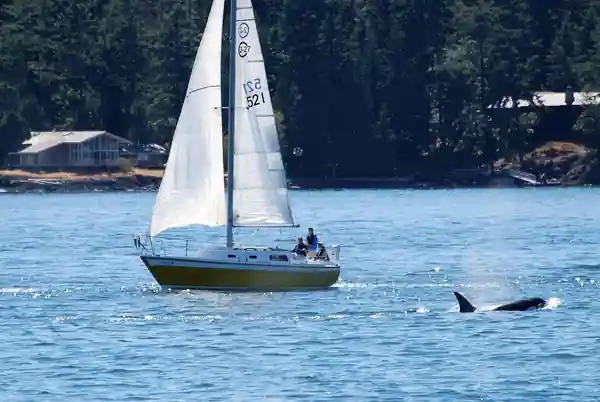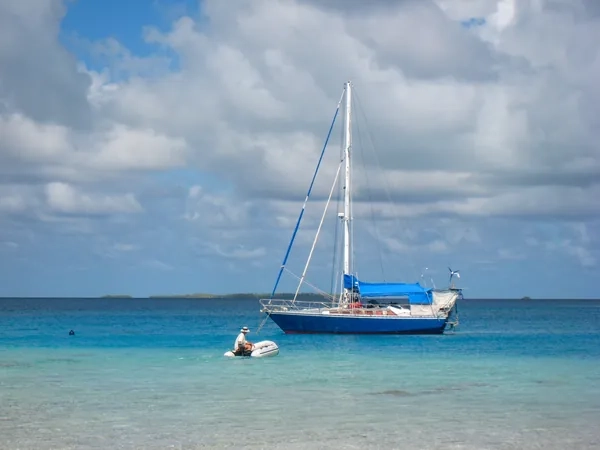Sailing is a tremendous opportunity for freedom, but it also entails responsibilities. Preserving marine ecosystems, limiting your impact on marine wildlife, while continuing to enjoy the ocean: it’s all possible if you take up some simple habits. Here are five fundamental tips to act responsibly when boating.
1. Plan your route to avoid protected areas
Responsible navigation at sea starts with respect for fragile ecosystems. Many marine areas are classified as protected. Anchoring, and in some cases even entry, may be prohibited. These restrictions are not there to make life difficult for yachtsmen, but to protect essential habitats from over-visiting: seagrass meadows, coral reefs, fish nurseries, nesting birds, and so on.
By preparing your route in advance, you can avoid these sensitive areas effortlessly. For example, it is generally forbidden to anchor in seagrass beds in the Mediterranean, particularly in the Balearic Islands in Spain. Several other locations are subject to strict regulations in Croatia, France, Italy and the broader Mediterranean region. In the Wadden Sea, a UNESCO World Heritage site shared by Denmark, Germany, and the Netherlands, strict regulations protect the unique tidal flats ecosystem. Similarly, the Great Barrier Reef Marine Park in Australia has specific zones where anchoring is prohibited to protect coral reefs.
In some areas, the use of mooring buoys is encouraged to avoid anchoring on sensitive seabeds. For instance, in the Florida Keys National Marine Sanctuary, mooring buoys are provided to protect seagrass beds and coral reefs. In Thunder Bay National Marine Sanctuary, on Lake Huron, moorings also allow boaters and divers to avoid damaging the many shipwrecks with their anchor rodes. In many italian protected areas, moorings also ensure visitors don’t anchor in Posidonia oceanica seabeds.
Additionally, some islands are off-limits during the nesting season. For example, strict seasonal closures are in place in the UK for the Farne Islands off the coast of Northumberland, Lundy Island, Skomer Island, the Isle of May and some islets or islands in the Isles of Scilly, as well as Skellig Michael in Ireland. Many similar restrictions exist around the world, so be sure to check in your area.
Some conservation parks even include core areas where strictly no human presence is allowed. This turns them into sanctuaries for marine wildlife. Some examples are Papahānaumokuākea Marine National Monument (Hawaii, US), Aldabra Atoll Marine Reserve (Seychelles) or the Yves Merlet Integral Reserve (New Caledonia).

To avoid mistakes, several boating apps chart restricted areas. Some even show marine conservation reserve areas, with specific instructions: reduced speed, no navigation, limited anchoring. Here are a few resources which might be useful:
- Protected Seas Navigator (whose data is integrated into Savvy Navvy)
- Navily
- Waterkaarten (for NW Europe)
- iNavX
- Nav&Co (in France)
What’s more, several of these apps display current Notices to Mariners in real time, a key element to check before each departure, as recommended in Ready4Sea’s setting off checklist.
However, keep in mind that regulations regarding protected areas can change from time to time. It’s important to stay informed before each trip. Please let us know of any inaccuracies or updates. We will update our articles accordingly, to help you enjoy responsible sailing.
2. Reducing noise pollution for responsible navigation
Responsible sailing also involves reducing noise pollution to protect marine wildlife and and out of consideration for others. Noise is an invisible yet very real form of pollution.
Cetaceans, in particular, are highly sensitive to underwater noise. It can interfere with their communication, orientation and reproduction. Dolphins and whales often flee from noisy areas, sometimes even abandoning their habitat.
To minimize this impact, here are a few guidelines:
- Speed Limits: Many countries enforce speed limits near the coast to reduce noise and prevent accidents. For example, in the United Kingdom, speed limits are often set in estuaries and near coastal areas to protect both wildlife and other water users. Similarly, in the Florida Keys, speed zones are designated to protect manatees and their habitats.
- Restricted Areas: In certain sensitive areas, boating is permitted but only under sail to minimize noise and environmental impact. For instance, in parts of the Dutch Wadden Sea, motorized navigation is restricted to protect the delicate ecosystem, allowing only sail-powered boats. And in the Gwaii Haanas National Marine Conservation Area (Canada), some zones restrict motorized vessels to protect cultural and natural resources, favoring sail power.
- Port Etiquette: In ports and marinas, it’s important to avoid running your engine or generator unnecessarily. Many marinas have noise regulations to ensure a peaceful environment for all users. For example, marinas in the Mediterranean and along the California coast often have strict rules about engine use and noise levels.
- Audio Devices: Reduce the volume of audio devices, especially at night or when anchored. Noise can travel far over water, disturbing both wildlife and other sailors seeking tranquility.
Before setting off, check local bylaws and regulations, as well as recommendations of nature reserves. For example:
- New Zealand: The Department of Conservation offers guidelines for visiting marine reserves, such as those around the Poor Knights Islands.
- United Kingdom: The Isles of Scilly and the Jurassic Coast have specific guidelines to protect their unique ecosystems.
- United States: National parks like the Channel Islands in California and the Everglades in Florida offer resources and guidelines for responsible boating.
- Australia: The Great Barrier Reef Marine Park Authority provides detailed information on navigating the reef responsibly.
- Italy: The Cinque Terre National Park, a UNESCO World Heritage site, restricts motorized boats in certain areas to preserve the coastal ecosystem and maintain the tranquility of this picturesque region.
Finally, consider switching to electric propulsion for a quieter sailing experience. Electric motors are becoming increasingly popular, especially for dinghies and small boats, due to their low noise and environmental benefits.
Sailing in silence shows respect for others and preserves a fragile environment. It’s a great way to discover the sea in a different way: by listening to the wind, the waves and the life around you.
3. Responsible navigation involves respect for marine life
Sensible boating also involves observing marine animals respectfully. Encountering dolphins or seabirds while sailing can be magical. However, to ensure the experience remains positive for both you and the wildlife, it’s essential to follow some simple guidelines.

Marine animals are particularly sensitive to stress. A sudden approach, high speed, or loud noise can disrupt their behavior. Some may flee, alter their migratory route, or even abandon their young.
Here’s how to behave responsibly while watching animals at sea:
- Keep your distance: at least 100 meters for cetaceans (dolphins, whales), and 300 meters from protected species such as seals. In some regions, such as the waters around Scotland, guidelines recommend even greater distances for certain whale species to avoid disturbing them.
- Reduce speed: As soon as you spot a group of animals, slow down to less than 5 knots and maintain a course parallel to theirs. This is crucial in sensitive areas like the Azores, where whale watching is a significant activity.
- Never chase them: Let the animals come to you if they wish. For certain species, such as orcas, specific recommendations are in place to limit interactions and preserve their tranquility. Always respect these recommendations!
- Avoid loud noises and bright lights: Refrain from shouting, playing loud music, or using bright flashes, as these can frighten or disorient the animals. This is particularly important in areas like the Bay of Islands in New Zealand, where dolphin watching is popular.
- Don’t fly drones over animals: Marine animals can perceive these as a predator or another threat and may cause them to flee. This rule is strictly enforced in many protected areas, including parts of the Australian coast and in the Faroe Islands.
In some areas, such as the Pelagos sanctuary (between France, Monaco and Italy), protection of marine mammals has been stepped up. Strict rules apply, with fines in the event of infringement. Similar protections are in place in the Stellwagen Bank National Marine Sanctuary off the coast of Massachusetts, where guidelines are provided to ensure responsible whale watching.
Did you know? Applications like iNaturalist or Whale Alert allow you to report your wildlife sightings to scientists. This simple action can contribute to the preservation of species and help researchers monitor marine life populations.
4. Choose biodegradable cleaning and hygiene products
On board, whatever goes down the sink or onto the deck sooner or later ends up in the ocean. Conventional household products, often loaded with phosphates, quaternary ammoniums or bleaching agents, can seriously harm marine fauna. Industrial dishwashing liquid or aggressive multi-purpose cleaners leave residues in the water that are toxic to fish, algae and micro-organisms.
You can minimize your impact by choosing gentle, biodegradable alternatives. For example, baking soda and white vinegar can be used in place of chlorinated detergents. Used successively, they are effective for descaling and cleaning surfaces. A vegetable-oil-based solid soap can replace conventional shower gels, which are often composed of silicones or sulfates. There are also ecological marine products designed specifically for cleaning hulls, without solvents or aggressive surfactants. This means they can be used outside hull-cleaning areas, without the need to collect rinsing water.

You can minimize your impact by choosing gentle, biodegradable alternatives. For example, baking soda and white vinegar can be used in place of chlorinated detergents. Used successively, they are effective for descaling and cleaning surfaces. A vegetable-oil-based solid soap can replace conventional shower gels, which are often composed of silicones or sulfates. There are also ecological marine products designed specifically for cleaning hulls, without solvents or aggressive surfactants. This means they can be used outside hull-cleaning areas, without the need to collect rinsing water.
Another important point when it comes to respecting the environment and current legislation in many countries is the use of holding tanks for black water. These tanks retain the wastewater from on-board toilets and allow it to be pumped out in specially designated areas, thus preserving water quality. Installing this system not only ensures compliance with regulations, but also contributes to the protection of endangered marine environments.
It’s another step towards truly responsible navigation at sea.

5. Respect the seabed with your anchoring line
Sustainable anchoring is also an integral part of responsible navigation at sea. It is an often underestimated source of damage. A poorly set anchor can tear up coral, damage seagrass beds or create destructive furrows on sandy bottoms.
Before dropping your anchor, take a good look at the seabed. Prefer bare sandy areas, avoiding visible seagrass beds. Some anchors, such as plow-shaped or quick-setting models, limit the damage. And if weather conditions allow, it’s preferable to reduce the chain length to prevent it from scraping the seabed.
Our suggestions:
- Check the bottom on a chart or with a depth sounder.
- Use a mooring ball to reduce the impact of your visit.
- In the absence of a mooring, use the fender anchoring technique to avoid direct friction with the seabed. This is particularly important when surrounded by coral.
- Give preference to precise, short-term anchoring.

Because being a boater also means becoming a guardian of the oceans. By taking up these simple habits, you’re helping to preserve our common heritage. So that tomorrow, cruising does remain a pleasure.
Ready4Sea helps you extend the life of your boat by keeping a close eye on its maintenance, thanks to its digital logbook. But what’s the point of preserving your vessel if you don’t also take care of the oceans? When you take up good sailing practices, you’re protecting what makes every trip so special: a healthy, living and preserved marine environment!
